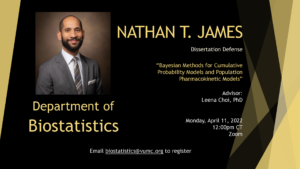Nathan T. James dissertation defense – April 11
PhD candidate Nathan T. James will be defending his dissertation on Monday, April 11, at noon Central Time. All are invited. To attend the defense, which will take place online, contact our department at biostatistics[at]vumc[dot]org for the link.

Bayesian methods offer many advantages in clinical trials, healthcare evaluation, and drug development, but their usage lags that of classical ‘frequentist’ methods. While some of this lag is related to philosophical disagreements, there is also a more practical component: despite advances in recent decades, much less methodological and computational work has been done to show how Bayesian methods can be applied to real world analyses. The goal of this dissertation is to demonstrate the use of Bayesian methodology in two application areas, semi-parametric modeling and population pharmacokinetic (PK) analysis.
For the first area, we describe an extension to the classical cumulative probability model (CPM) to perform Bayesian semi-parametric regression modeling. We show how Bayesian CPMs can be reparameterized to handle a large number of ordinal categories and characterize the performance of these models with continuous or mixed continuous and discrete outcome data. For the second area, we investigate an approximate estimation method, automatic differentiation variational inference (ADVI), to reduce computation time for Bayesian population PK modeling. Using simulation studies, we compare ADVI and Markov Chain Monte Carlo (MCMC) estimates of population and individual parameters and predicted concentrations and examine the performance of several model selection strategies. Next, we describe a frequentist population PK analysis of the sedative dexmedetomidine in a pediatric cohort using real-world data collected from electronic health records and remnant specimens. Then, we perform a Bayesian reanalysis using ADVI and MCMC to address some of the limitations of the frequentist analysis by incorporating external evidence from previous studies. We conclude by summarizing the work and discussing future research directions.
